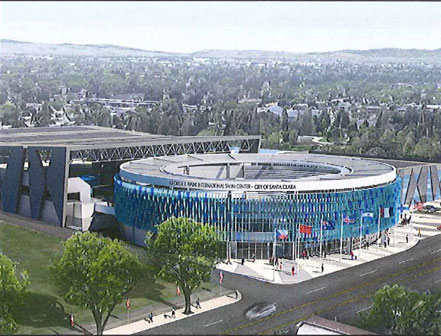
The place that grew champions like Donna DeVarona and Mark Spitz should shout that history. That’s the idea behind a new design for replacing the aging George F. Haines International Swim Center (ISC), unveiled at a June 24 Santa Clara City Council study session.
In addition to its ultramodern architecture, the new proposal puts the ISC front and center on Kiely Boulevard, creating an eye-catching attraction to draw high-profile events. The new design features a circular “water pavilion” seating 1,800, conventional competition stadium pool seating 3,800, and third pool for practice and training. The layout connects the Swim Center with the Community Recreation Center (CRC) – which will be renovated – and adds a gymnasium and parking structure. The current CRC theater would stay.
The new design puts the ISC on current CRC parking lots, so the rebuild would free up three acres for parkland. The center also aims to generate all its own electricity, and possibly provide enough to power the library and park.
The concept has many advantages. One that neighbors will like is that cars won’t be entering the center through residential streets. Kiely provides easy access – both by car and for pedestrians, and giving the entrance a “grand boulevard” feel wouldn’t be difficult, said architect Clarence Mamuyac, principal at Berkeley-based ELS Architecture and Urban Design (www.elsarch.com) who has been working with the city and Santa Clara aquatics clubs for two years on the re-design. The plan would also allow the ISC to operate during construction.
Plus, talks have been underway for several years to bring the International Swimming Hall of Fame (ISHOF) to Santa Clara when its Fort Lauderdale lease is up next year. To date, there’s been no formal commitment, but that could change if the new design goes forward.
The new plan presents attractive opportunities for the city. A world-class attraction, that looks like one, would be a draw for high profile events bringing revenue into the city – think 2024 Summer Olympics – and offsetting operating costs. Currently, less than 25 percent of the ISC’s operating costs are covered by revenue, according to the report.
But there are also big challenges. Topping the Council’s list is parking. Although the new garage adds 90 spaces, it’s only 242 total spaces – hardly enough for a venue attracting thousands.
No one has to speculate about how big this problem is. For decades, large events in Central Park have consistently caused traffic and parking nightmares for both visitors and residents, over an extensive area from San Tomas to Lawrence and Benton to Pruneridge.
“It’s very under parked,” said Council Member Lisa Gillmor. “So I want to make sure there’s enough parking on the site…so there’s not parking in the neighborhoods, because that’s where the excess cars end up. I want to make sure we have enough parking for the full use of everything.”
An even bigger challenge is how to pay for the new ISC, given Santa Clara’s depleted capital fund and still unresolved redevelopment agency disputes with the county over hundreds of millions in city assets.
The city’s aquatic clubs – the Aquamaids, Santa Clara Swim Club, and Santa Clara Diving – have already announced a capital campaign, and City Manager Julio Fuentes considers some type of public-private funding partnership a given. However, Council Member Teresa O’Neill noted, “with capital campaigns I know it’s a lot easier [to get commitments] than when the checks have to get written. How much of this would we potentially have to finance?”
“The city will have to come up with some creative ways to build it,” responded Fuentes, who, with less than two years on the job, has already demonstrated his creativity at finding solutions to seeming impasses. “Yes, the operational costs will double. But what you will get from having this facility, and the program and events and meets that will be held there – it will be a truly special place.”
A final challenge is one that isn’t about numbers, but something more intangible. If the new ISC lives up to its billing, it will bring “a whole different feel to Central Park,” said O’Neill. In other words, it’s going to bring to Kiely Boulevard some of the major-league vibe that Levi’s Stadium has brought to the Northside. And some undoubtedly won’t like it. “I’m anticipating that we’re going to hear from the people who live on Kiely,” said O’Neill. “And something that I hear constantly is about the traffic.”
However, people don’t have to worry just yet about tourists swarming down Kiely in search of Spitz. There’s plenty of work ahead before a concrete proposal comes forward. Next steps include community meetings, the requisite Environmental Impact Report, answers to the parking and funding questions, and a detailed cost and revenue analysis.
“It’s a good first look,” said Mayor Jamie Matthews. “I like the idea that we’re reclaiming park space [and] opening up green space by building on a parking lot. The Center in its current location certainly doesn’t work. It has a terrible impact on the neighborhood. Santa Clara has an amazing history of swimming. If we can address the traffic and parking issues, we have a storied tradition that we can reclaim and celebrate.”
Find ELC’s full presentation at http://sireweb.santaclaraca.gov/sirepub/cache/2/5zpmsq03naos5kbh2zcjodft/69031907152014014902350.PDF.





